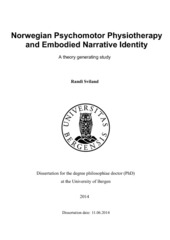| dc.contributor.author | Sviland, Randi | en_US |
| dc.date.accessioned | 2014-10-06T13:11:59Z | |
| dc.date.available | 2014-10-06T13:11:59Z | |
| dc.date.issued | 2014-06-11 | eng |
| dc.identifier.isbn | 978-82-308-2884-7 | en_US |
| dc.identifier.uri | https://hdl.handle.net/1956/8594 | |
| dc.description.abstract | The aim of this thesis is to explore and develop the theoretical underpinning of Norwegian Psychomotor Physiotherapy (NPMP). In the first part (Paper I, II & III), the theoretical grounds for this physiotherapy treatment approach are analysed from their historical origin. The theoretical assumptions derived from this were used to analyse patients’ experiences in the second part (Paper IV & V). Thus, theoretical assumptions were illustrated and challenged from a clinical perspective raising new questions, which demanded further theoretical extensions. The theoretical part is based on hermeneutic text analysis using the methods of investigation of sources. Texts written by the Norwegian psychiatrist Trygve Braatøy, a primary source for the theoretical assumptions in NPMP, were analysed in the light of Løgstrup’s philosophy of sensation. In Paper I the functional meanings of muscular actions emerge as ambiguous in interdependent tension between posture and movement. NPMP emerges as a treatment involved with the existential challenge of withholding and expressing oneself. Paper II explores how muscular tension, sensation, awareness and understanding interact. Paper III elaborates on the embodied foundation of expressing oneself in everyday language. The first clinical study, a case study, explored the experience of one patient’s 10 yearlong treatment processes. Analysis of enacted narratives emerging during these clinical situations revealed the significance of a narrative perspective. They pinpointed the meaning of time, in relation to muscular tension, posture, movement, sensation and understanding, as aspects of narrative identity. The narrative perspective was further expanded in the second clinical study, which was based on focus group interviews, exploring how patients make meaning of their experience with NPMP. When explored in relation to narrative genre, NPMP emerged as a journey of transformation where time and trust are foundational. Embodied changes are associated with narrative identity and finding one’s own voice, as well as the urge to speak out and reflect on significant experiences of the past. It is a process, which seems to challenge peoples experience and concepts of control. This thesis opens up a theoretical underpinning, where the comprehensive perspective in NPMP is seen as an embodied treatment affecting the tension between the spontaneous, interwoven presence of life and, the distancing function of the individual person’s existential struggle to become him or herself. Muscular, postural and respiratory transformations, the essential issues in NPMP, emerge as processes which involve patients’ narrative identity on an embodied sensuous level. The notion of control is challenged in these processes where trust emerges as essential, and each patient’s cycle of treatment will be of different lengths. Embodied transformation of muscular and sensuous traces of past experiences may evoke reminiscences, which demand to be expressed and, open speech requires attentive listening. NPMP is understood in the light of an existential journey of transformation, with a potential vitalising capacity. | en_US |
| dc.language.iso | eng | eng |
| dc.publisher | The University of Bergen | eng |
| dc.relation.haspart | Paper I: Sviland R, Martinsen K and Råheim M. (2007) Hvis ikke kropp og psyke – hva da? Holdning og bevegelse i selvutfoldelse og tilbakeholdelse. Fysioterapeuten 74(12): 23-28. The article is available at: <a href="http://hdl.handle.net/1956/8593" target="blank">http://hdl.handle.net/1956/8593</a> | en_US |
| dc.relation.haspart | Paper II: Sviland R, Råheim M and Martinsen K. (2009) Å komme til seg selv - i bevegelse, sansning og forståelse. Matrix 26(2): 257-275. The article is available at: <a href="http://hdl.handle.net/1956/8626" target="blank">http://hdl.handle.net/1956/8626</a> | en_US |
| dc.relation.haspart | Paper III: Sviland R, Råheim M and Martinsen K. (2010) Språk – uttrykk for inntrykk. Matrix 27(2): 132-156. The article is available at: <a href="http://hdl.handle.net/1956/8627" target="blank">http://hdl.handle.net/1956/8627</a> | en_US |
| dc.relation.haspart | Paper IV: Sviland R, Råheim M and Martinsen K. (2012) Touched in sensation – moved by respiration. Embodied narrative identity – a treatment process. Scandinavian Journal of Caring Sciences 26(4): 811–819. The article is not available in BORA due to publisher restrictions. The published version is available at: <a href="http://dx.doi.org/10.1111/j.1471-6712.2012.01024.x" target="blank">http://dx.doi.org/10.1111/j.1471-6712.2012.01024.x</a> | en_US |
| dc.relation.haspart | Paper V: Sviland R, Martinsen K. and Råheim M. (2014) To be held and to hold one’s own: Narratives of Embodied Transformation in the Treatment of Long Lasting Musculoskeletal Problems. Medicine, Health Care and Philosophy 17(4): 609-624. The article is not available in BORA due to publisher restrictions. The published version is available at: <a href="http://dx.doi.org/10.1007/s11019-014-9562-0" target="blank">http://dx.doi.org/10.1007/s11019-014-9562-0</a> | en_US |
| dc.title | Norwegian Psychomotor Physiotherapy and Embodied Narrative Identity. A theory generating study | en_US |
| dc.type | Doctoral thesis | |
| dc.rights.holder | Copyright the author. All rights reserved | |
| dc.identifier.cristin | 1136153 | |

